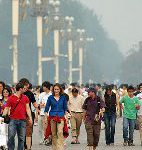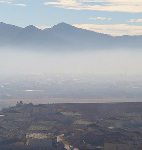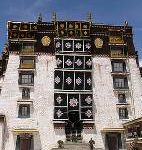When I asked one of my Chinese hosts to give me a tour of his city’s best new housing project, I never imagined it would inspire a University of California, Berkeley, team to propose revolutionising how the Chinese develop their new communities.
We set out from the Urban Planning and Design Institute’s offices in a black diplomatic car, with a siren I quickly learned allowed us to exercise authoritative traffic privileges. Our route out of metropolitan Tianjin, China’s third-largest city, took us along a major arterial corridor to the northwest, which was clogged with traffic of a chaotic type unmatched in the U.S.
Intersections, even though signalised, presented a terrifying game of “chicken”. Cars, trucks, and buses wove through an equal number of bicyclists (often with multiple passengers or goods) and pedestrians. The dust and pollution were so intense that most bicyclists wore face masks. With siren blaring, we sped along the shoulder, past what appeared to be an unending series of developments, including a new college campus, high-tech office parks and multiple high-density housing developments. As far as the eye could see, the entire landscape seemed under construction.
The scale of infrastructure construction to support this kind of hyper-development in China is hard to imagine. It is estimated that China builds more than fifty 300-megawatt coal-fired power plants per year. California has only built 36 in the last five years. China is undertaking the largest road construction program in the world, equivalent to the US Interstate highway system begun in the 1950s. The capital and material costs of this effort are increased by the fact that, in most areas of infrastructure, China is playing catch-up.
For example, an estimated 60% of existing sewage is dumped into rivers, untreated. Not only is the cost of building sewer mains and centralised treatment plants for new development staggering, but also, without cleaning up the existing sewers, the polluted rivers magnify the challenge of delivering sanitary drinking water. Some urban planning scholars question whether the current rate of development is economically sustainable, but if it is, it is estimated that China will double the size of its built environment in the next 20 to 30 years — the equivalent of building two new Britains.
When the pollution and carbon dioxide (CO2) emissions from the congested arteries are combined with that from the power plants required to meet the energy demands of new development, the impact on both China’s public health and on global climate change presents major challenges for the years ahead. Four-fifths of China’s largest cities have unacceptable air quality, resulting in more than 600,000 premature deaths from asthma, emphysema and lung cancer. Currently, it is estimated that China is responsible for 25% of the world’s CO2 emissions (the United States is at 30%). At its current rate of development, China is projected to surpass the US in the next few years.
Mounting scientific evidence has shown conclusively that the current cycle of global warming is not natural, but attributable directly to man-made CO2 emissions; and while the projections vary in magnitude (from 2 C to 10¾ C), the projected impact of global warming on the earth’s natural systems is catastrophic. On balance, the question becomes: Can the world dramatically cut back its CO2 emissions to avoid these catastrophic scenarios? The responsibility falls on the US and China to show the way.
Fortunately, China has recognised this challenge and it has been seeking the best urban planning and design advice and concepts from around the world. Our Berkeley team was invited by the Tianjin Urban Planning and Design Institute to assist the city of ten million residents in developing principles and prototypes for compact, transit-oriented, commuter gateway neighbourhoods promoting efficient land use, and relying more on public transportation and bicycles and less on cars. With half the population living outside Tianjin proper, the city recognised that it was necessary to build a public-transit system of underground (subway) trains, light rail and connecting buses in order to avoid the traffic congestion afflicting Beijing and Shanghai.
Having completed two of seven planned light-rail lines, the city sought advice on how to guide development around the station stops. Berkeley’s College of Environmental Design responded by forming an interdisciplinary team of faculty and students from each of its three departments — Architecture, City and Regional Planning, and Landscape Architecture and Environmental Planning — to come up with design proposals that address critical real-world problems. The Tianjin Urban Planning and Design Institute funded the semester-long project, which included a week-long visit to the Chinese city followed by analysis and preliminary designs. In Berkeley, three Chinese scholars joined the 15-member team to help inculcate the project with the nation’s cultural and practical realities. But what unfolded during the semester was largely due to the impact of what we found during our Chinese tour.
At our destination, we passed through an entry gate, where we were saluted by two uniformed guards, and proceeded to an elegant marketing showroom complete with a scale model of the entire development and elaborate models of each unit type for sale. The plan was based on repetitive blocks of townhouses and flats; their designs were of high quality, similar to what might be seen in the Netherlands, Germany or Scandinavia.
Vehicular and pedestrian access to the housing units was provided by uniform street grids with limited parking at the units and overflow parking along a fence forming the community’s perimeter. Much attention had been paid to landscape design. Streets, sidewalks and pathways of various paving materials were shaded by an array of trees. The project also featured several small parks, schools, a small central commercial area, recreation facilities, and a lake with multiple high-rise residential towers overlooking it.
I quickly estimated the density at approximately 75 to 100 units per acre. As I explored the project with my Chinese host, who was justifiably proud of its design quality, it dawned on me that what was being sold was a gated, privatised urbanity — a carefully controlled development with an urban theme but without any of the nitty-gritty reality of the city. Moreover, the gated entry gave residents a sense of belonging to a privileged community. It was hard not to interpret this as a form of social segregation.
Our hosts showed us multiple examples of the same model throughout the city — gated superblocks within a grid of new arterial streets at approximately one-mile or 1.2-mile intervals. One opportunistic developer was already in the process of building a gated superblock on the site where we were asked to explore transit-oriented development. Immediately, we became concerned. The project under construction effectively served only the residents within the gated community, blocking pedestrian and bike access to the light-rail station for anyone else. Residents of other developments would be forced to walk or bike a mile or more to get around the first development.
I wondered: Did our Chinese hosts not see this contradiction? Were they looking for alternatives?
The author: Harrison S. Fraker Jr. is dean of the College of Environmental Design at the University of California, Berkeley.
Reprinted with permission from California magazine
Homepage photo by Chris Drumgoole




